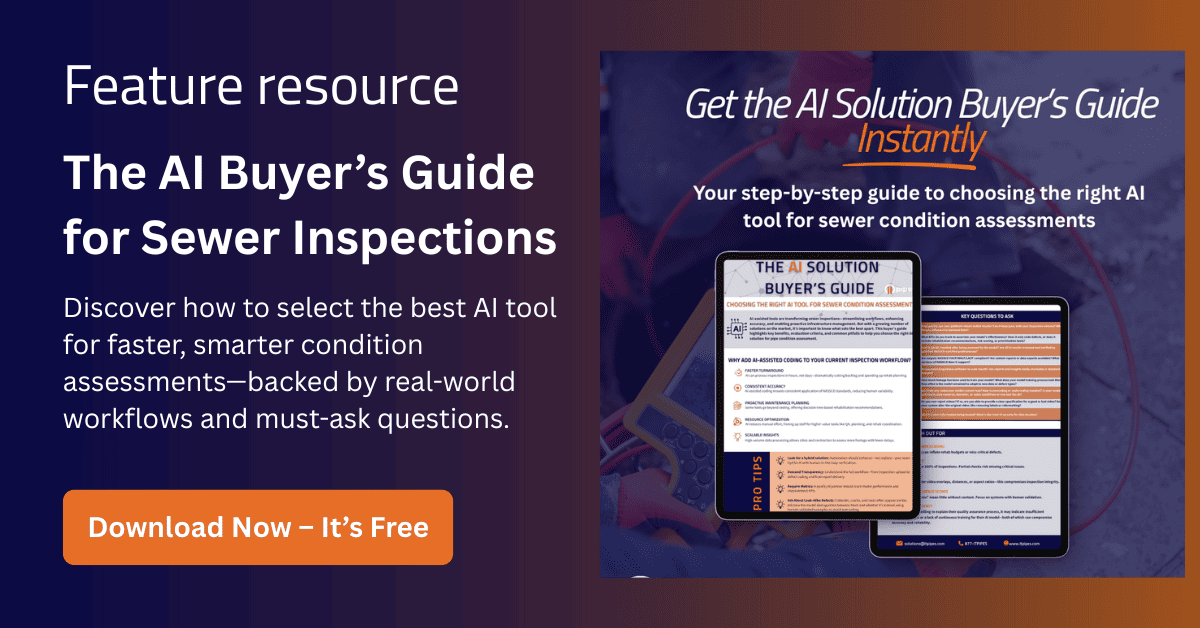AI-assisted technology is quickly becoming a game-changer in the world of sewer and pipeline management. As your team deals with growing inspection backlogs, aging infrastructure, and tight budgets, the need for faster, more accurate condition assessments has never been greater.
That’s where AI comes in.
Unlike traditional inspection workflows that rely solely on human review, AI-assisted tools can process footage in hours rather than days. This drastically cuts turnaround time and accelerates rehabilitation planning. But the real magic of AI isn’t just speed—it’s consistency.
The Power of Consistency
Human error and variability can impact the accuracy of defect coding. AI helps eliminate that risk by applying NASSCO standards with a high level of consistency. Some platforms even go beyond defect tagging, offering decision-tree-based rehab recommendations.
But let’s be clear: AI should never replace your team. The best solutions use a hybrid approach, partnering artificial intelligence with human oversight and verification to ensure quality and accountability.
Boosting Efficiency Without Sacrificing Accuracy
AI also frees up your staff for higher-value tasks, such as QA, planning, and coordinating rehab efforts. Instead of burning time on initial coding, staff can focus on decision-making and data validation. With scalable AI tools, even high-volume cities can clear backlogs faster and deliver proactive maintenance.
Pro Tip: Choose a partner that provides transparency in their QA process, tracks model performance metrics, and offers clear insight into how their AI distinguishes between similar-looking defects
Empowering Smarter Infrastructure Planning
AI-assisted insights don’t just streamline inspections—they help organizations plan ahead. By providing consistent, high-quality data, AI tools enable teams to prioritize repairs based on risk, budget smarter, and take a proactive stance on infrastructure maintenance. With better data in hand, leaders can make more strategic decisions that extend asset life and minimize emergency repairs.
Traditional vs AI-Assisted Workflows
| Task | Manual Workflow | AI-Assisted Workflow |
|---|---|---|
| Initial Coding Time for One Mile of Pipe | 16 hours | 4–6 hours |
| QA/QC Review | 100% manual | Human Oversight |
| Inspector Role | Review every frame | Validate flagged defects |
AI doesn’t eliminate the need for your team—it empowers them to do more, faster, and with better data.
Common Misconceptions About AI in Inspection
- “AI replaces humans” → False. The most effective tools are designed for collaboration, not replacement.
- “AI is only for large cities” → False. Many scalable tools are tailored to serve smaller municipalities, contractors, and engineering firms.
- “AI coding can’t be trusted” → False. With human oversight and verification, model training, and quality checks, AI is as reliable and more consistent than manual human coding alone.
Best Practices When Evaluating AI Tools
- Ensure human oversight QA is part of the workflow
- Ask how the model identifies and differentiates similar-looking defects
- Request performance metrics like model accuracy and average turnaround
- Confirm the AI does not alter or reformat inspection videos
- Look for tools that provide NASSCO-compliant reports and export options
- Choose vendors who retrain their models regularly to improve accuracy
Conclusion
AI is no longer a futuristic concept—it’s a practical, impactful tool that forward-thinking organizations are using today. By reducing backlog, increasing consistency, and supporting smarter planning, AI enhances both the speed and quality of pipeline inspections. When paired with expert oversight, it becomes a force multiplier for infrastructure teams.
Call to Action
Thinking about AI for inspections? Download the AI Buyers Guide to compare tools, uncover key evaluation criteria, and avoid costly mistakes.

